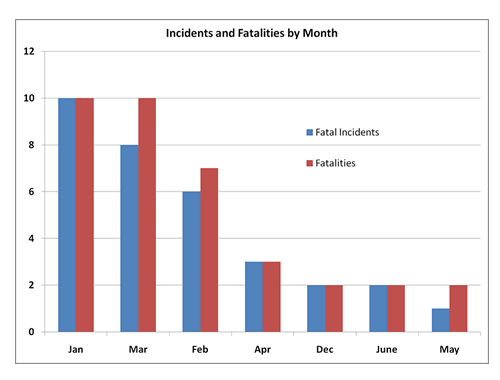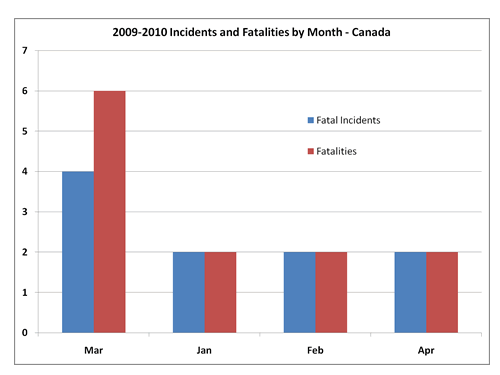March 17, 2011: Spring Incidents, Lessons from Last Season
Comments on this post are disabled because it is an old post and the spam bots have now discovered it. If you would like to comment or to arrange a related guest post contact the avalanche center at snow@csac.org
As we begin to enter the spring season the snowpack tends to become more stable, or at least more predictable. But it can take a while to get there. And of course every year is different.
Early spring is always a transition period. Spring conditions are developing but winter weak layers are still active.
Combine these transitional snowpack conditions with longer days, and often with good weather, and the result can be more incidents. At least some years. Every year differs, and different locations have snowpacks that develop differently.
The bottom line, though, is to be careful during this period. As the following two graphs from last season show there can be a large number of accidents in the spring months in relation to the rest of the year.
The first chart is for the US. You can see that last year March was tied with January for the most fatalities in a month, leading even February. It was second in the number of accidents that included one or more fatalities. In April the numbers really dropped off. May and June generally see a few mountaineering accidents.
US 2009-10 Accidents by month:

The second chart is for Canada last season and the difference is even more pronounced.
Canadian 2009-10 Accidents by month:

Remember that these graphs are just for the 2009-10 season, and that every year is different. The snowpack transition from a winter to a spring structure happens differently every year. It can be earlier or later, faster or slower.
A few years ago in many parts of western Canada the spring was cool and wet until very late, at which point rain suddenly fell up to high elevations. This rainfall on a wintery snowpack caused widespread wet snow avalanches and very dangerous conditions as late as May.
So remember that avalanche season is rarely over in March, in fact it may just be peaking in March or April some years.
As we begin to enter the spring season the snowpack tends to become more stable, or at least more predictable. But it can take a while to get there. And of course every year is different.
Early spring is always a transition period. Spring conditions are developing but winter weak layers are still active.
Combine these transitional snowpack conditions with longer days, and often with good weather, and the result can be more incidents. At least some years. Every year differs, and different locations have snowpacks that develop differently.
The bottom line, though, is to be careful during this period. As the following two graphs from last season show there can be a large number of accidents in the spring months in relation to the rest of the year.
The first chart is for the US. You can see that last year March was tied with January for the most fatalities in a month, leading even February. It was second in the number of accidents that included one or more fatalities. In April the numbers really dropped off. May and June generally see a few mountaineering accidents.
US 2009-10 Accidents by month:

The second chart is for Canada last season and the difference is even more pronounced.
Canadian 2009-10 Accidents by month:

Remember that these graphs are just for the 2009-10 season, and that every year is different. The snowpack transition from a winter to a spring structure happens differently every year. It can be earlier or later, faster or slower.
A few years ago in many parts of western Canada the spring was cool and wet until very late, at which point rain suddenly fell up to high elevations. This rainfall on a wintery snowpack caused widespread wet snow avalanches and very dangerous conditions as late as May.
So remember that avalanche season is rarely over in March, in fact it may just be peaking in March or April some years.

